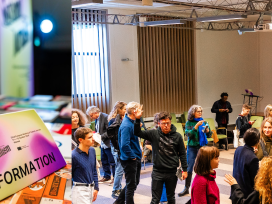Examples of successful democracies are abundant in the South, at least according to many western observers. Yet, except in the case of Turkey, the third wave of democratisation seems to have bypassed the Muslim world. But are the deficient or hybrid democracies that predominate in Latin America and, particularly, sub-Saharan Africa – regions where the West, with its sense of social and cultural superiority, has such a powerful influence – any better? These imperfect democracies deliberately strive to maintain their imperfections in the interests of the powerful and barely present a more favourable picture than do the struggling democracies of Northern Africa.
The “Arab spring” pleases all those who have long hoped that resistance in the Muslim world to old-fashioned dictatorships would develop spontaneously, without visible organisation. When the street manifested itself they saw their hopes fulfilled that the Western ideals had taken roots also in the Arab world. Unfortunately for these postmodern admirers of spontaneous liberation, the Arab spring has run into difficult waters, causing what can only be described as dejection. In both Cairo and Tunis, there has been a breathtaking growth in the number of political parties without members and of discussion forums with only limited audiences. The failure of any operational project of social transformation to emerge from the “Arab spring” recalls post-revolutionary developments in Algeria in 1988-1989. Then and now, those who want to establish democracy assume that the mere withdrawal of the state from the economy, the end of corruption-ridden and inefficient state interventionism, as practised by the fossilised dictatorships, will bring about economic growth. The new difficulties have provoked belated soul-searching in the West about the relation of the revolutions with Islamist movements. But not all hopes have been defeated: despite the dreaded prospect of Islamisation becoming a reality, voices claiming that some Islamists may be reliable partners are now being listened to.
Mono-disciplinary eurocentrism, isolated from questions of political economics – a result of the departmental “organisation” of American universities, and, admittedly, of intellectual laziness – conceals the specificity of the western experience. Contrary to the accepted wisdom, this specificity consists not in a more efficient exploitation of labour, but in the fact that the scarcity of labour imposed limits to exploitation. Behind the smokescreen of idle talk, inspired by a self-proclaimed “cultural turn” (Huntington distinguished one Hindu and one Islamic culture, but a large variety of Christian ones), the economic bases of the bourgeois revolution disappear as by magic. Concealed by controversies over mechanistically conceived links between the possibility of democracy and the minimum level of productivity, there is no discussion about the possibility of existing on the labour market as the precondition for an economic empowerment of the large mass of citizens.

Egyptian bread, symbol of the protest
All theories on the South – whether they are based on the theory of imperialism, of unequal international division of labour, or on underdevelopment – share one conviction: that, with some exceptions (East and Southeast Asia), underdeveloped Third World economies are unable to create full employment solely on the basis of an increase of domestic mass consumption. If mass incomes increase, inflationary processes are triggered off. The balance of trade becomes negative, since even if production is re-oriented towards mass needs, the necessary means of production would have to be imported. New orientation hence requires initial support. The economy will respond to market signals only if it has acquired a minimum level of flexibility and hence coherence. This may require, for example, a planned establishment of production capacities to meet basic mass consumption needs, or to provide equipment in order to make labour productive. As long as this restructuring of the productive potential has not been completed, there can be no stable mass political power, since the masses are not scarce on the labour market, even if they succeed in liberating themselves at the political level.
The relation between bourgeois revolution – which aims at the overthrowing of non-democratic political structures – and social revolution – which aims at the empowerment of the subalterns not through private ownership but through being scarce on the labour market and therefore employable – will inevitably differ entirely in underdeveloped economies and developed capitalist countries.
Bourgeois revolution and proletarian revolution
Analysts agree that the political revolution, also called the bourgeois revolution, has not overcome poverty in Europe. During the revolutionary processes in Britain and France, movements emerged that fought for another type of society. Socialism before Marx or agrarian communism were based on philosophies oriented towards supporting the increasingly destitute and marginalised masses, in order to liberate them from their miserable conditions. In the Communist Manifesto, Marx largely brought together various socialist traditions and movements.
Marx’s analysis of capitalism, based as it was on a deconstruction of the mechanisms of alienation and capitalist exploitation, proved incorrect in the light of later developments, at least with respect to three important issues:
– its rejection of the possibility of permanently increasing mass incomes and mass consumption;
– its rejection of the possibility of stabilising a market economy via decentralised management focused on the “commanding heights”, especially global demand, which is ultimately mass demand;
– its assumption of the inevitable character of unlimited exploitation in order to maintain accumulation under the conditions of capitalist growth.
Let us have a brief look on the evidence. Mass incomes and, especially, real wages have increased continuously since the Industrial Revolution, and hence in continental Europe, since the middle of the nineteenth century. Real wages increased earlier in England and the most egalitarian societies have shown the highest dynamism. Even before Keynes formulated his theory of stabilising global demand by state expenditure, the working classes in Europe imposed such employment programmes in the form of emergency employment in case of economic crisis, and not only during the French Revolution of 1848. European economic crises provide proof that, unlike the clerks and intellectuals, the masses understood the link between empowerment through employment and the fulfilment of the promises of capitalism as formulated by its supporters. In mature capitalist economies, the capital-output ratio is stable. This limits the need of financial resources for investment, and consequently also the amount of profit. This insight comes from Keynesianism; nevertheless, it is integrated into neoclassical theories of endogenous growth in order to castrate it from its political implications, i.e. that capitalism depends on the empowerment of the masses. The subaltern classes in the West have shown by their practical struggles, not by their writings, that they have understood the link between the mode of operation of capitalism as defined by bourgeois economists (nowadays neoclassical economics) and the necessity of non-commodity type treatment of labour. Working conditions and salaries are therefore negotiated at a political level of confrontation between labour and management. The subaltern classes have understood that their rise was a condition for the health of capitalism, not the result of it. Increasing mass incomes create new possibilities for profitable investment. In Keynesian theory, spending on investment is the basis of profit and, at the same time, of new jobs through which scarcity of labour and the empowerment of labour simultaneously emerge.
It is this virtuous circle that does not exist in underdeveloped economies. Nobody denies that, historically, some of these economies, India as well as China, were at some point technically advanced and even superior to Europe. But in both countries, nobody was capable of turning these skills to the advantage of the popular masses. Other underdeveloped economies were relatively backward in mastering their natural environments by means of technology. For the more developed economies, technical proficiency implied comparative advantage in luxuries that the less civilised Europeans imported massively, up until the Industrial Revolution, under the name of chinoiseries – Chinese products. When technical discoveries made available new luxuries, specialisation in raw materials became imperative for less developed countries, entailing comparative disadvantage in the production of new technologies.
Based on his criticisms of the limits of the bourgeois revolution, Marx and nearly the whole Left after him searched for an alternative to the market, which they often characterised as association-based. However, while associations are perhaps more open to participation than the state, like any organisation they are characterised by more by clientelism than a state of law. For these reasons, the middle classes are very much in favour of associations, which today are called non-governmental organisations. In contrast, the popular classes have much better understood the fundamental mechanisms of capitalism, which work in their favour. This understanding is manifested by the insistence on the priority of high levels of employment as the basis of capacity to behave as independent individuals in relation to other structures of society.
Hence, any strategy that aims at stabilising democratic revolutions in the Arab world has to prioritise economic development in the interest of the masses, and must do so by rapidly creating reasonably paid jobs as the basis of the empowerment of those voters upon which any democracy is based.
Channelling rent into jobs
If the Arab revolutions are to be victorious, rent must be used for jobs and for job creation. High levels of employment depend on demand for products produced by local labour with low shares of imported goods (technologies, raw materials). Internal demand for products of local origin has to be increased. At low technical levels, an economy is relatively better in producing simple products. Such products are manufactured with simple equipment, which can be locally manufactured. With a more equal distribution of household incomes, greater production of such goods may favour the local production of equipment needed to produce them, thus creating an additional multiplying factor for employment. The argument was used in Algeria in the 1970s in order to justify the economic strategies of Houari Boumedienne. Boumedienne, however, realised that the centralisation of rent inevitably created a multitude of possibilities for the illicit enrichment of those in charge of managing it.
To appeal only to managers’ faithfulness to the revolutionary ideals of the national liberation struggle would be to fall into the trap of idealism. The economy and society have to be organised according to principles that limit opportunities for bad management and that can be operated by people of average qualities. Yet although the necessity of launching the internal market is beyond doubt in order to raise employment, without the parallel creation of reasonably paid jobs there is also the administrative difficulty of imposing an egalitarian distribution of income. These difficulties account for the importance of the second alternative, namely to increase export of manufactured products.
The success of the East and Southeast Asian countries in transforming their societies by increasing exports of manufactured products depended on the low cost of labour as a major element of overall costs. But low costs of labour were achieved primarily not by low real wages but by the devaluation of the national currency below purchasing power parity. According to World Bank statistics, Chinese per capita national product was four times higher in purchasing power parity than on the basis of the exchange rate at the time China launched its export offensive. In other words, the salaries of Chinese workers bought four times as many products on the Chinese market than they would have had they been exchanged into an international currency such as dollars and then used on international markets. Workers consume more than their contribution to exports yields in income if used for purchases abroad. This difference, this additional consumption, has to be paid for by somebody. The additional production cannot be purchased abroad, since these workers make no contribution to foreign exchange to the amount of their additional consumption. The difference between their real consumption on the one hand, and the international purchasing power of what is their due from their participation in export production on the other, has to be produced locally. There has to be a local production of consumer goods for low income households. In economies in which levels of household consumption are low, food constitutes an important part of mass consumption. Popular consumption is therefore satisfied predominantly by local agriculture. A highly productive agricultural sector allows exports of manufactured products on the basis of the transformation of comparative advantage into cost competitiveness by means of devaluation. Devaluation at the same time creates low international costs of labour in return for increasing employment and increasing real wages in return for increasing internal demand. This creates incentives to increase the production capacities of the local economy. Production and employment increase in the wake of more empowerment of labour through more employment. Herein lies the explanation for the success of the countries of East Asia, where the Green Revolution led to the highly productive paddy production.
Because of climatic conditions, agriculture in the Arab world is weak. This weakness keeps the Arab world from following Asia’s devaluation-based strategy of employment creation. This could be the basis for an intensified cooperation between a food surplus Europe and the Asian and African Mediterranean rim. Europe has a long-run comparative advantage in food production. If the Arab world were to catch up economically and industrially with Europe, the latter would become the breadbasket of the former.
If Europe wants to support the Arab revolutions, it must allow overall economic development in the South of the Mediterranean. As any economy, also the Arab countries have less backwardness in some manufactures than in others. They have therefore comparative advantage somewhere, and not only in Oil production. Such comparative advantage is kept from becoming competitiveness because of the high export earnings from oil – the Dutch disease. Such comparative advantage can become competitiveness through appropriate exchange rates, which partially insulate the Arab economies from the consequences of the oil manna on their exchange rates. Arab countries should deliberately devalue their currencies in order to make their labour competitive on their own markets but also on the international market. Europe should promote the transformation of existing comparative advantage in some sectors of manufacturing, also in Arab economies, into cost-competitiveness, at appropriate exchange rates. For this, the Arab countries have to have access to cheap supplies of food. They could come from Europe and compensate for the absence of a success of the Green Revolution in the Arab world, to the difference of East Asia. As shown by East Asia, this development would allow Europe and the Arab world to bridge their differences in development in a short time. Both would be able to achieve similar levels of development, where trade no longer implies unequal specialisation, but rather intra-industry specialisation, as between advanced industrial countries.
Self-centred development does not imply dissociation and withdrawal from the world market. Rather, it entails maintaining control over the direction of development, and this can be compatible with a large-scale opening up to the world market.
How to create genuine political revolution
The Arab revolutions share with the Algerian crisis of 1988 the following points:
– Rent-based state classes have lost any aspiration to transform society in the direction of improving the material conditions of the masses, the subalterns. Such state classes have therefore become discredited.
– The democratic opposition has been decisively strengthened by youth, who aspired to freedom.
– There have been no precise projects for creating an alliance of revolutionary forces that would lead to durable organisations capable of developing and operationalising detailed and practical policies with a mid-term horizon.
These element are interwoven with contradictory signs of an identity crisis that keeps people vacillating between two poles: on one hand, an Islamisation aiming at the moral restoration of society; on the other, a westernisation that is appealing for its freedoms and opportunities for consumption.. The new emerging powers (China, India, Brazil) play no role in this ideological chaos. They define themselves as members of the new Westphalian system, i.e. as completely sovereign powers. Their overriding concern is to defend their sovereignty, rather than to organise the world on the basis of their own principles of economic and political organisation, as the colonial European powers did until 1945 and the United States and the Soviet Union continued to do in the second half of the twentieth century. The emerging nations are reproached by the western powers for pursuing such goals because of the latter’s ideas about “good governance”.
In the developing situation, the attractiveness of political Islamism appears diminished. Where political Islamism has been in power, it has not delivered – it has failed to realise its promises. There are, however, positive examples. All agree that in Turkey political Islamism has, to a large extent, become a moderate movement capable of creating large class alliances and combining market-based industrialisation and social programmes in favour of subalterns. It is conceivable that moderate Islamist tendencies will gain importance as the rather empty concept of a moral economy that is at the centre of Islamist economic thinking (a market economy with relatively frequent but unsystematic state intervention in order to preserve interests that cannot stand on the market) opens up perspectives of pragmatic solutions that combine market and planning including an opening to the world market.
At the global level, the state classes that came into power immediately after political de-colonisation need to admit their failure in industrialisation via import substitution on the basis of protected home markets. In the Arab world, this failure has been caused by the weakness, sometimes also by the absence, of any commitment to creating structures of income distribution that favour mass consumption by poor households. However this would have been the only basis for the possible success of industrialisation via this concentration on the home market via import substitution. Facing difficulties in maintaining social cohesion after the loss of ideological legitimacy, the state classes have turned to the West. The West is ready to accept them in order to block Islamism, which surged after the Iranian revolution. It is the fear of Islamism that brought the two partners together, rather than any sympathy. We find in this alliance with the West state classes of the most diverse origins and ideological orientations, from Sadat and Mubarak (heirs of Nasser) to Muamar al-Gaddafi, also including the current Algerian leadership and the former Tunesian leaders around Ben Ali.
Even in their cooperation with the West and its international institutions, the state classes were unable to manage the still available rent. They did not understand the causes of the success of East and Southeast Asia. On the contrary, they defended the overvalued exchange rates of their currencies as much as they could. Only in the wake of financial crises on the world market did they became disillusioned, at which point devaluation was imposed on them from outside. They are still unable to utilise external constraints creatively and transform them into opportunities for overcoming the crisis. As a result of the successive failures of state classes, along with the decline in the more radical tendencies of Islamic fundamentalism, the western powers have finally accepted to countenance certain moderate Islamist tendencies and establish with them a minimum degree of contact.
The youth and middle classes have been able to turn down political strategies based on intimidation (“there is no alternative”) and the security services. They have successfully opposed state classes that had no other policies but austerity and no other social basis than small groups of privileged subalterns. These movements are progressive and deserve our sympathy. However they will only be able to maintain their social cohesion and ideological coherence if they launch an economic and social project capable of creating and crystallising a debate on long-term perspectives, which can then serve as the basis for a strong and representative political organisation. If these conditions are met, they will be able to set the course of development. However such debates will not be created through cell phones and the cyber revolution.
For those who want to become true citizens through protest and commitment to the political revolution, the central element is access to an economic basis. This would allow them to become true bourgeois individuals committed to democracy. Employment, paid on the basis of productivity, and hence employment that yields economic surplus, would also provide a counterweight to those who organise production, and hence to those in control of the places of employment, whatever the historical form of property.
These social movements have been born spontaneously. They have no experience of the protracted struggles fought in the form of class conflicts. It will be very difficult for them to develop such strategies. The state classes in power may well retain their grip as the revolutionaries face increasing – and increasingly visible – difficulties in designing and implementing realistic economic strategies. The failure to push the political revolution into the direction of social revolution will inevitably reinforce the other pole of opposition – identity politics, which is to say political Islamism. But a strengthening of political Islamism will not necessarily strengthen those Islamists who are taking the course of pragmatism and moderation in identity politics. The possibility of a repeat of the Algerian tragedy following 1988 can no longer be excluded.








